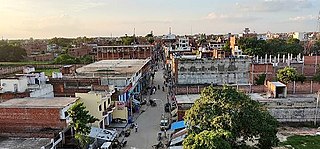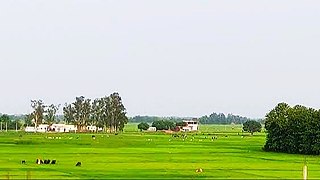Bhabhua(spelled asBhabua) is a Holy Land And Sacred City of Maa Mundeshwari in Kaimur District under Bihar State.

Kaimur district is one of the 38 districts of Bihar, India. The district headquarters are at Bhabua. Before 1991, it was part of Rohtas District. Till 1764 the region was a part of Ghazipur District and was a part of Kamsaar Raj and later it was a part of Chainpur Estate till 1837.

Ghazipur district is a district of Uttar Pradesh state in northern India. The city of Ghazipur is the district headquarters. The district is part of Varanasi Division. The region of Ghazipur is famous mainly for the production of its unique rose-scented Spray called Gulab Jal, and for the tomb of the Governor General of British India, Lord Cornwallis, who died here. His tomb is situated in Western part of City, and is conserved by Archaeological Survey of India.

Dildarnagar Fatehpur Bazar is a neighbourhood of Dildarnagar, located in the Ghazipur district of the Indian state of Uttar Pradesh. It is situated on the banks of the River Ganges and is approximately 35 kilometers from the city of Ghazipur. The town is known for its historical and cultural significance, and it has several temples, mosques, and other landmarks that attract visitors from different parts of India. Dildarnagar is also an important commercial center and has a bustling market where locals and visitors can purchase a variety of goods and products. As of 2011 estimate the Population of Dildarnagar is 12855 and have an area of 1000 hectares.
Zamania is a town in the Indian state of Uttar Pradesh. Its municipal council is subordinate to the Ghazipur District. It is also the administrative head of Zamania tehsil,. It is also a very historical town, it derives its name from Ali Quli Khan Zaman, who was also known as Khan Zaman or Zaman Khan, he was a governor of Jaunpur, and Ghazipur during the time of Akbar.
Mohania is a city and corresponding community development block in Kaimur district of Bihar, India. It serves as headquarters for the Mohania sub-division in Kaimur district. It is 17 km (11 mi) by road north of the city of Bhabua, at the intersection of National Highway 19, NH-219, and NH-319. The bank of the Durgavati River is just to the south of Mohania. The total block population was 218,479, in 32,198 households.

Bhabhua Road Junction is a railway station on the Grand Chord line on the outskirts of Mohania, 10.25 miles (16.50 km) from Bhabua in the Indian state of Bihar. It is also on the route of the Grand Trunk Road. It has five platforms. It is a B Grade station in Kaimur district recognised by Railway of India. As of 2022, over 70+ trains from various starting stations pass through the station daily.

Dildarnagar Kamsar is a pargana (region) and a mashra comprising 34 settlements located around the Karamnasa River in the Ghazipur district of Uttar Pradesh and the Kaimur district of Bihar, India. Of these, 18 mouzas are the primary settlements. It is a prominent settlement of Khanzadas, also known as Kamsari Pathans, as well as Afghan Pathans, primarily of the Niazi and Yusufzai clans. The original name of the region was Kamsar, but due to close and historical ties with the family of Bara Pathans, the region is often referred to as Kamsar-O-Bar. It was established in 1542 by Raja Narhar Khan.

Usia is a village in Kamsaar, Uttar Pradesh, India. It is located southeast of Ghazipur and east of Dildarnagar, near the Bihar State border. The village has a population of 24,786 residents living in 3,471 households. Usia is approximately 7 km from Dildarnagar. Around 8500 Kamsar Pathans lived here as of 2011.

Kurrah or Tajpur Kurrah is a village in Dildarnagar Kamsar region of Zamania tehsil in Ghazipur district. It is avillage of pathan Kamsaari pathans in the Indian state of Uttar Pradesh. Almost 3900 Kamsaar Pathans lived in the village as of 2011.

Saraila is a village in Kamsaar in the Indian state of Uttar Pradesh.Saraila is a village in Seorai Tehsil in Ghazipur District of Uttar Pradesh, India. It belongs to Varanasi Division. It is located 30 km to the south of District headquarters Ghazipur. 11 km from Seorai. 372 km from State capital Lucknow. The village was also a part of Daudpur Estate which had its capital at Dewaitha during Mughal and early British era.

Bara is a village of Dildarnagar Kamsar in Ghazipur district in the Indian state of Uttar Pradesh. It is situated on the banks of the holy river Ganges.
Dumri is a village in Dildarnagar kamsar located in Durgawati tehsil of the Indian state of Bihar. Dumri is large village and have svetalaana small villages or hamlets which are relative villages of Dumri which makes it the largest Gram Panchayat of Durgawati tehsil.
Mapatpur is a small village in Nuaon Tehsil in Ramgarh Block in Kaimur district of the Indian state of Bihar. It comes under the Panchayat raj political system and belongs to the Patna Division.
Akbarpur is a village in Rohtas block of Rohtas district, Bihar, India. Located on the bank of the Son river, a short distance east of the historic Rohtasgarh fort, Akbarpur is the headquarters of Rohtas block. As of 2011, it had a population of 9,236, in 1,491 households. Akbarpur covers 333 hectares and 6.73 km2.
Mahārāja Kam Dév Singh Urf Rao Dalpat Karam Singh (1438–1532) was a Sikarwar Bhumeehar, king of the Kanyakubja Gotra and belonged to Sikri dynasty, which ruled over the region of Fatehpur Sikri and then Fatuhabad near Fatehpur. He was ruler of the Pahargarh Estate, which mainly comprised what are now the cities of Morena, Gwalior, Jhansi, and Shivpuri, in old Rajputana region. Kam Dev was the son of Maharaja Jay Raj Dev Singh who was the ruler of the Vijaypur Sikri state. With this Kam Dev and Dham Dev were an ally of Rana Sanga.
Seorai is a village of Dildarnagar Kamsar, and also serve as the headquarters of SeoraiTahsil in region of Ghazipur District of Uttar Pradesh, India. The Seorai tehsil was made a tehsil of the Ghazipur District in year 2016. It consists of 142 villages and one town. Seorai main village has a total area of 878.02 hectares and a population of 20000 but its total area is 1,082.83 hectares and a population of 20,530 which also includes Bhadaura. Seorai tehsil has the total area of 366.62 km2 (141.55 sq mi). Seorai also served as the capital of Kamsaar estate from late 1500s to mid 1600s.
Ikhlaspur is a large village in Bhabua block of Kaimur district, Bihar, India. As of 2011, its population was 11,820, in 2,042 households. It covers an area of 439 hectares, of which 401.7 were used for farmland.

Dildarnagar is a municipality in Kamsaar of Ghazipur District, Uttar Pradesh, India. Dildarnagar is a fast-developing town. It is located 34 km from Ghazipur. It is also known as the heart of the Kamsaar-o-Bar region. The total area of Dildarnagar includes Fatehpur Bazar, Dildarnagar Gao, Tajpur, and Nirahukapura. These four neighbourhoods form the town of Dildarnagar. As of the 2011 census, the population of Dildarnagar was 28,913 and the town had an area of 1,995.95 hectares. Dildarnagar is on the road from Varanasi to Buxar. It was also the capital of Dildarnagar Estate.
Dewaitha is a village of Dildarnagar Kamsar,in Zamania tehsil of Ghazipur, India, located on the banks of the Karmanasa River and it's tributary Eknaiya, The village had a population of 7,104 as of the 2011 Census of India. The place is inhabited by Kamsar Pathans..










